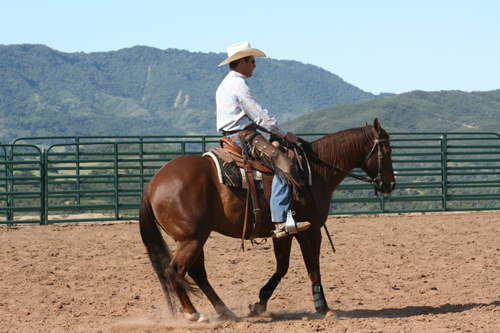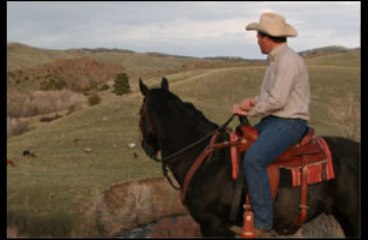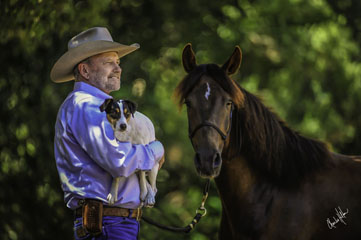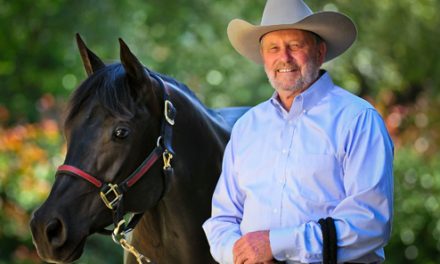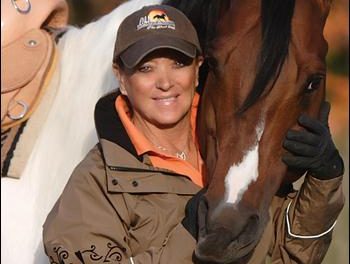 Whether you are a weekend trail rider or a high-level performance horse trainer, stopping, and stopping correctly, is an absolute necessity. Let’s look at some basic elements to this maneuver. There are three cues that we can use to ask for the stop. I generally use all three in concert each time I ask my horse to stop. They are body position, voice, and hands. Let’s look at each one independently.
Whether you are a weekend trail rider or a high-level performance horse trainer, stopping, and stopping correctly, is an absolute necessity. Let’s look at some basic elements to this maneuver. There are three cues that we can use to ask for the stop. I generally use all three in concert each time I ask my horse to stop. They are body position, voice, and hands. Let’s look at each one independently.
Body Position
If we want our horse to have a definite transmission, or shifting of gears through the walk, trot, lope, stop, and back, then our body must also have this same transmission. We must be able to bring up the life in our body for forward momentum in our horse. And we need to be able to sit down in our saddle (often referred to as “quit riding”), to shift down to a slower gear or stop. From the very first ride I put on a colt, I use this body language. I shift my weight forward and bring up the life for forward motion. I shift my weight back and “quit riding” to slow back down or stop. A pack horse learns early on that the load on his back is dead weight. If the pack leans left or right, forward or back, it has absolutely no meaning. Unfortunately that’s what a lot of saddle horses have concluded as well. We need to prove to our horse that he is not just a pack animal carrying dead weight. We must communicate our intentions with our body language. It’s no mystery how the horseman performs a bridleless riding demonstration. It comes from the consistency and clarity of the rider’s body movement and position. Don’t underestimate what your body language can do to communicate your intentions.
“Whoa” means stop
In almost every equine discipline, the voice cue is the same. Whoa. If you want this verbal cue to be effective, only say it when you mean it. In other words, “whoa” does not mean: slow down, watch out, easy boy, be careful, oh my goodness, or anything else. It only means stop. That is the only time I say it. If we want to promote a better stop, reserve that special word to mean only that — the termination of forward motion.
Hands
Our hands can be considered the promise behind the suggestion. We suggest with our shifting weight and verbal cue. If there is no response, you can reinforce the cue with your hands. Don’t pull on the reins to stop your horse. Only pull on the reins if he doesn’t stop. Actually, it’s more like holding firm on the reins rather than pulling. If my horse stops well at my suggestion (body and voice) then the reins don’t have to be activated. If he ignores my suggestion, then he will “run into my hands” and find discomfort until he ceases forward motion and softness off the bit.
Don’t attempt to stop with long reins. Be prepared before you say “whoa” by shortening your reins and having your hands out in front of you. If your hands are back by your stomach, you’ll be very limited in your effectiveness in stopping, backs, or softening your horse in the bridle. I tell my students, “If you can stop or back your horse and scratch your belly at the same time, your reins are too long!”
Having our hands forward, with shorter reins, and holding them firmly in our hands will convey clearer communication and better control.
One thing we can do to enhance the stop is to take a few steps backwards every time we say whoa. We want our horse to think that the word “whoa” actually means “get back.” The quicker he gets back, the better his stop will be. Those few steps backward are also an opportunity to soften our horse in the face and make sure he is giving to the bridle. We want our horse to know that getting back with a soft feel is the quickest and best way to find his comfort zone. If he sticks his nose out when we say whoa, this gives us an opportunity to reinforce the idea of vertical flexion, and backing up reinforces the concept of shifting their weight to their back end when they stop.
Every horse I’ve seen that could stop well also backed up readily and softly. If you are struggling with whoa, consider how well your horse backs up. Improve the quality of backing and it will pay dividends when you ask for the stop.
Remember, everything must be taught at the slower speed first. If our horse is not getting good grades at the walk and trot, it is guaranteed it will fall apart when more speed is added.
As with anything, consistency is paramount. Consistent clarity with our body, voice, and hands will lay a foundation for the stop that will last a lifetime. Please Google “RWintersHorsemanship Youtube” for footage that compliments this article.
Next month we’ll take a more advanced approach and demystify the “Sliding Stop.”
Richard Winters is a performance horse trainer with a natural horsemanship touch. For over 20 years, he has helped people with their horses through his training programs, clinics, DVDs, and his presentations at horse expos. His horsemanship is universal, ranging from reined cow horses on the Western side to jumping and dressage on the English side. Learn more about Richard at www.wintersranch.com.
Richard just won the 2009 Road to the Horse Colt Starting Competition in Franklin, Tennessee and will be competing again next year. Richard will also be a the Western States Horse Expo June 12 – 14.

